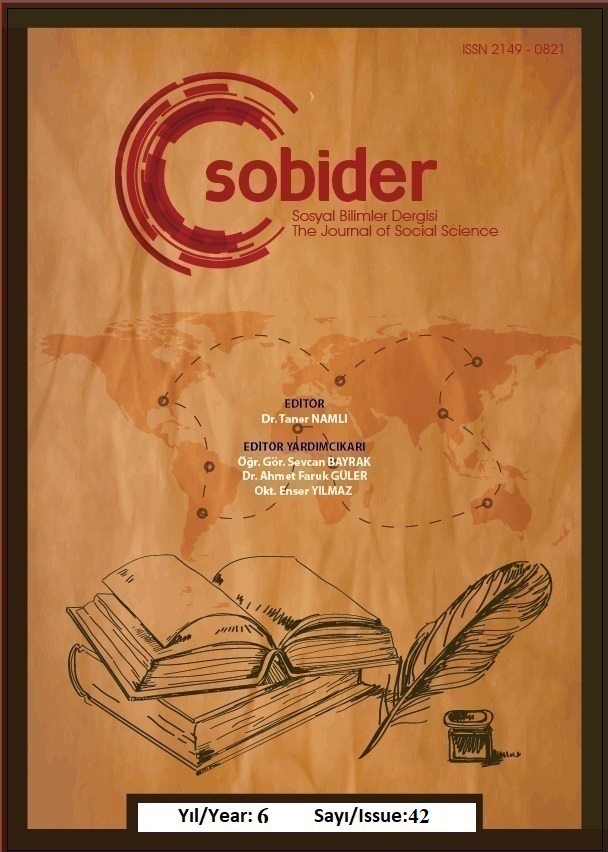Author :
Abstract
Roman kişilerine dair değerlendirmelerde kullanılan kavramlardan biri de ‘tip’tir. ‘Tip’, tipikliğiyle öne çıktığı, içinde bulunduğu dönemin toplumsal belirleyicileriyle anlam bulduğu kadar bireyselliğiyle, ferdî zenginliğiyle de var olur. Temsil ettiği tipiklik, bireysel bir yaşantıyla birleşir, somutlaşır ve kendine özgü bir şahsiyetin öne çıkan parçası olur. ‘Tip’, üzerinde taşıdığı ‘tipiklik’in yanında ‘birey’ olarak var olmayı başaran roman kişisidir. ‘Tip’in şahsında, dönemsel çizgilerle resmedilmiş ‘tipiklik’; bireysellikle, ferdî zenginlikle ve içsel gerçeklikle tam bir sentez oluşturur. Kudret Yanardağ, Orhan Kemal’in biri diğerinin devamı niteliğinde olan Müfettişler Müfettişi (1966) ile Üç Kâğıtçı (1969) romanlarının başkişisidir ve 1940’lar sonu, 50’ler başı Türkiye’sinden sosyal bir ‘tip’tir. Bu çalışmanın başlıca amacı, Kudret Yanardağ’ı bir ‘tip’ örneği olarak değerlendirmek ve somut bir örnek üzerinden ‘tip’ kavramını tartışmaktır.
Keywords
Abstract
One of the concepts used in evaluations of the novel’s persons is ‘type’. ‘Type’ comes into being with its individuality and individual wealth, as well as with its social determinants of a period and its typicality. The typicality which is represented by the ‘type’ merges with an individual life, becomes embodied and becomes the prominent elements of a distinctive personality. ‘Type’ is a novel person who succeeds to exist as an individual in addition to his ‘typicality’. In personality of ‘type’, typicality which is illustrated by periodic lines constitutes a complete synthesis with individual, individual wealth and inner reality. Kudret Yanardağ is the protagonist of Orhan Kemal’s novels, the Müfettişler Müfettişi (1966) and Üç Kâğıtçı (1969), and is a social type in Turkey in the end of 1940s and the beginnig of 1950s. The main purpose of this study is to evaluate Kudret Yanardağ as an example of ‘type’ and to discuss the concept of ‘type’ through a concrete example.
Keywords
- Akyürek, F. (2008). Senaryo Yazarı Olmak: Senaryo Yazmak. İstanbul: MediaCat Kitapları.
- Akyürek, F. (2008). Senaryo Yazarı Olmak: Senaryo Yazmak. İstanbul: MediaCat Kitapları.
- Aytür, N. (1974). Amerikan Romanında Gerçekçilik 1870-1900. Ankara: Ankara Üniversitesi DTCF Yayınları.
- Belge, M. (1998). Edebiyat Üstüne Yazılar. İstanbul: İletişim Yayınları.
- Bourneur, R.; Quellet R. (1989). Roman Dünyası ve İncelenmesi. (çev. H. Gümüş), Ankara: Kültür Bakanlığı Yayınları.
- Boulton, M. (1975). The Anatomy of the Novel. London, Boston, Melbourne and Henley: Routledge&Kegan Paul.
- Boynukara, H. (2002). “Karakter ve Tip”. Hece, 65/66/67: 174-187.
- Butor, M. (1991). Roman Üstüne Denemeler. (çev. M. Rifat-S. Rifat), İstanbul: Düzlem Yayınları.
- Çetin, N. (2004). Roman Çözümleme Yöntemi. Ankara: Öncü Basımevi.
- Çetişli, İ. (2004). Metin Tahlillerine Giriş 2: Hikȃye-Roman-Tiyatro. Ankara: Akçağ Yayınları.Çiftlikçi, R. (2000). “Türk Romanında Tip ve Karakter Problemi”. Yedi İklim, 123: 42-52. Demir, A. 2014. Roman ve Stereotip. Ankara: Nobel Yayınevi.
- Eliuz, Ü. (2006). Küçük Adam: Orhan Kemal Romanlarında Yapı ve İzlek. Ankara: Öykü Emil, B. (1989). Reşat Nuri Güntekin. Ankara: Kültür Bakanlığı Yayınları.
- Forster, E. M. (1985). Roman Sanatı. (çev. Ü. Aytür), İstanbul: Adam Yayınları.
- Forster, E. M. (1988). “Düz ve Yuvarlak Karakterler”. Roman Teorisi. (ed. P. Stevick), (çev. S. Kantarcıoğlu), 170-178, Ankara: Gazi Üniversitesi Yayınları.
- Gültekin, M. N. (2012). “Bir Anlatı Ustasının Penceresinden Toplum, İnsan, Dönem”. Orhan Kemal (ed. A. Ümit-I. Öğütçü), 39-65, Ankara: Kültür ve Turizm Bakanlığı Yayınları.
- Gürsel, N. (1997). Başkaldıran Edebiyat. İstanbul: Yapı Kredi Yayınları.
- Harvey, W. J. (1988). “Romanda Sosyal Ortam”. Roman Teorisi. (ed. P. Stevick), (çev. S. Kantarcıoğlu), 178-198Ankara: Gazi Üniversitesi Yayınları.
- Kaplan, M. (2009). Türk Edebiyatı Üzerine Araştırmalar 3: Tip Tahlilleri. İstanbul: DergâhLukacs, G. (1975). Çağdaş Gerçekçiliğin Anlamı. (çev. C. Çapan), İstanbul: Payel Yayınevi. Lukacs, G. (1987). Avrupa Gerçekçiliği. (çev. M. H. Doğan), İstanbul: Payel Yayınevi.
- Narlı, M. (2002). Orhan Kemal’in Romanları Üzerine Bir İnceleme. Ankara: Kültür Bakanlığı Narlı, M. (2004). “Roman İncelemesi Üzerine Notlar”. Türk Dili, 634: 463-476.
- Narlı, M. (2013). “Romanlar ve Taşralar: Türk Romanında Taşra Algıları Üzerine Bir Değerlendirme”. bilig, 64: 285-316.
- Orhan Kemal (1970). Müfettişler Müfettişi. İstanbul: Varlık Yayınevi. Orhan Kemal (1985). Üç Kâğıtçı. İstanbul: Tekin Yayınevi.
- Tekin, M. (2006). Roman Sanatı 1: Romanın Unsurları. İstanbul: Ötüken Neşriyat.
- Tilbe, A. (2010). “Georg Lukacs ve Lucien Goldmann’ın Yaklaşımıyla Fransız Yazınında KişiSorunsalı”. Batı Edebiyatında Kahraman. (ed. E. İşler vd.), 27-36, Denizli: Pamukkale Üniversitesi Yayınları.
- Toker, Ş. (1990). Hüseyin Rahmi Gürpınar’ın Romanlarında Alafranga Tipler. İzmir: Ege Üniversitesi Edebiyat Fakültesi Yayını.
- Wellek, R.; Warren, A. (2005). Edebiyat Teorisi. (çev. Ö. F. Huyugüzel), İzmir: Akademi Kitabevi.
- Yavuz, H. (1977). Roman Kavramı ve Türk Romanı. Ankara: Bilgi Yayınevi.
- Yavuz, H. (1982). “Romanda Tip Olgusu ve Tip’in İşlevi Üzerine (soruşturma-Z. Karabey)”. Yazko Edebiyat, 24: 100-102.





